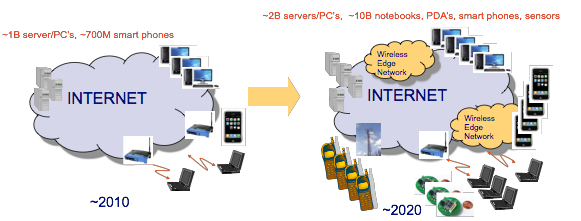| Version 12 (modified by , 7 years ago) ( diff ) |
|---|
Mobility First : Multihoming Extension
Introduction
MobilityFirst (MF) is an emerging proposal for the new standard of the 5G networking! Mobility first takes a new approach to the Internet by focusing on increasingly dominating communications of mobile devices. The new architecture will pave the ground for a variety of new features including improved scalability, robust wireless signals, enhanced security, a context-sensitive network among other goodies. More information about MobilityFirst can be found on their website (link). A brief introduction of the relevant concepts are summarized below.
 This diagram illustrates a projection with increased dominance of mobile devices present in the network. Gone is the dominance of the server-client model - awaken mobile devices''
This diagram illustrates a projection with increased dominance of mobile devices present in the network. Gone is the dominance of the server-client model - awaken mobile devices''
The old TCP/IP model worked great with servers and desktops that staid put for most of the time. A desktop computers' identity is closely attached to its network address. With MF, identities of machines (ID) are separated from their network address (NA). Instead of using static IPs to identify machines, all devices now have Dynamic Name Address Bindings. These bindings are called Global Unique Identifiers (GUID). In such a way, a group a devices owned by a single user can share the same GUID. Hence, all machines must go through a Global Name Resolution Service (GNRS) which indicates the routing needed to reach said address. The GNRS uses a Distributed Hash Table (DHT) to store routing information in a loosely decentralized way. Unlike the current routing methods of DNS, GNRS stores tons of metadata within the network to make context-dependent situations. Some examples include performing multihoming or allow for geolocation.
Multihoming is a concept that allows for a single device to use multiple interfaces at once. Our goal is to implement multihoming in the MF framework and create improvements to the the efficient division of work between hosts as well as proper lead balancing throughout the network said data is routed through.
People
This project is coordinated by Brian Qiu and Ramnya Tadepalli.
With thanks Ivan Seskar for hosting the Summer 2017 WINLAB intern program for which the project would not exist without.
Presentations
Attachments (8)
-
mf_quick.png
(73.2 KB
) - added by 7 years ago.
mobility first MF quick explanation diagram
-
amiga.png
(121.5 KB
) - added by 7 years ago.
brian
- ramya.png.png (115.5 KB ) - added by 7 years ago.
-
finalRouterSetup.png
(45.8 KB
) - added by 7 years ago.
router setup we used
-
mfDiagram2.svg
(115.7 KB
) - added by 7 years ago.
a setup we used
- personOnPhone.png (20.5 KB ) - added by 7 years ago.
-
time.png
(23.8 KB
) - added by 7 years ago.
graph
- multihomingSticks.png (34.8 KB ) - added by 7 years ago.
Download all attachments as: .zip

